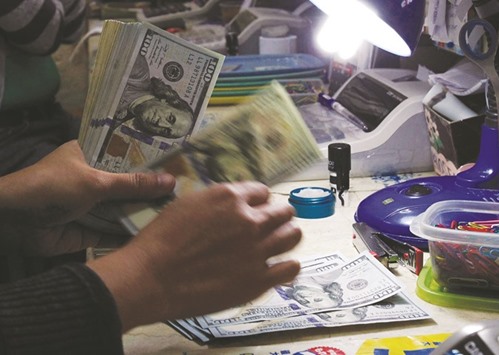Just as the dollar heads for its worst month since 2011, selling the currency is about to fall out of vogue.
Hedge funds cut bets on further gains in the dollar to the lowest since 2014 prior to last week’s Federal Reserve meeting.
With speculators having already ditched the US currency, few are left to sell and push it down further, making the greenback less susceptible to rapid outflows of hot money, according to analysts at JPMorgan Chase & Co.
That has the downturn, already into its second month and reaching a magnitude similar to the dollar’s only other major decline of the past two years, poised for a reversal.
Investors are trying to assess whether the Fed’s scaled-back forecast for interest rate hikes, depicted by the so-called dot plot, signals the end to a rally in the dollar, or just a blip on the path to further gains.
Options traders expect the greenback to strengthen versus 14 of 16 major peers this year with the Fed still poised to tighten policy while other major central banks boost stimulus.
“The market’s shown us that positioning just isn’t supportive of any kind of move of this magnitude,” said BlackRock’s Tushar Yadava, a San Francisco-based investment strategist in the company’s iShares unit. “Given the fact that we’re still looking at decent data and a Fed that’s telling us they’re going to move two times this year, it still looks likely that we’re going to see at least a moderate move back.”
Markets went into a tailspin last week when the Fed halved its projected interest-rate increases for 2016, damping one spur of the US currency’s near 20% ascent since mid-2014.
The Bloomberg Dollar Spot Index fell to a nine-month low in the wake of the meeting and is down 3% in March, poised for its worst month since April 2011.
Analysts at JPMorgan wrote in a March 18 note that they are “wary of a bear trap” and see a broad measure of the currency finding a floor in the near term.
“The positions for hedge funds are very light,” said John Normand, the bank’s London-based head of foreign exchange, commodities and international rates research. “The broad index can fall another couple of%, but the lack of extreme positioning and overvaluation that has preceded previous FOMC press conferences should limit its downside,” he wrote last week.
Hedge funds and other large speculators reduced wagers that profit from gains by the dollar against eight major peers to a net 88,214 contracts in the week through March 15, the least since July 2014 and down 80% from record long bets of 448,675 contracts in January 2015, data from the Commodity Futures Trading Commission show.
Those record bets were rapidly unwound in March 2015, spurred by an unexpectedly dovish Fed policy statement. In the weeks that followed, Bloomberg’s gauge of the dollar slumped 6%, the measure’s steepest decline since early 2011.
One-year risk reversals show investors are still preparing for broad dollar gains versus its major peers - little changed from the start of the year - with traders paying more for options to sell currencies including the euro and British pound versus the greenback than to buy them.
That’s because while the Fed has lowered its projected rate path, the rest of the world is standing pat or easing monetary policy.
Europe unveiled a comprehensive extension to its stimulus program earlier this month, boosting bond buying and lowering interest rates, and Japanese policy makers have hinted at more to come after cutting rates into negative territory in January.
“If the Fed can’t deliver on those two rate hikes, then that’s much more problematic from a dollar bull case,” said Alan Ruskin, global co-head of foreign-exchange research in New York at Deutsche Bank.
“As little as it is, it’s not that little in relation to what everybody else is doing, so I still think that will be at least moderately constructive” for the dollar.
Traders are pricing in a 46% likelihood of a rate increase by the Fed’s June meeting, and a 76% probability that the central bank will lifts borrowing costs by December, based on the assumption that the effective fed funds rate will trade at the middle of the new Federal Open Market Committee target range after the next increase. That’s down from 54% and 80% on March 15.
The US currency is forecast to rally versus all 16 of its major peers other than the pound by year-end, with the median estimate of strategists surveyed by Bloomberg seeing the dollar rising about 4% versus the euro and 6% against the yen.
“The dollar will strengthen,” said James Kwok, the London- based head of currency management at Amundi, which manages more than $1tn. “The positioning is a key reason why we saw the dollar going down a lot recently. But now if the positioning is more clear, then the market will go back to see the fundamentals of the US”.

A money changer counts US dollar bills at a currency exchange in Manila. Hedge funds cut bets on further gains in the dollar to the lowest since 2014 prior to last week’s Federal Reserve policy meeting.
